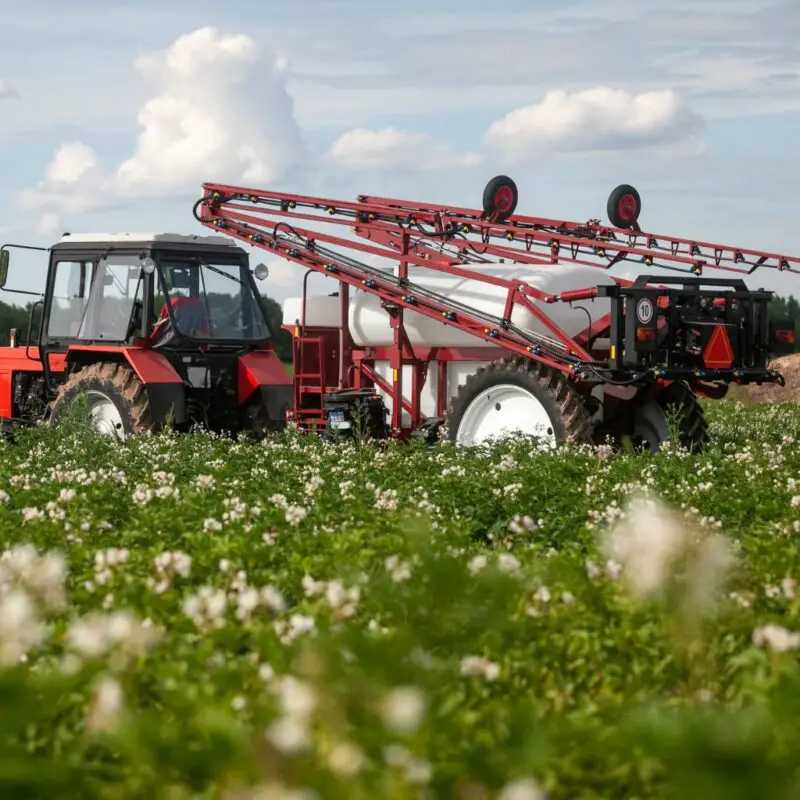Agricultural boom sprayers are essential tools that farmers use in modern large-scale farming. If you have ever passed one on a country road or seen one in the field you know that these machines are impressive in size and sophistication. Whether you have seen one in person or not you may be curious as to why they are so complex, what they spray, or what exactly their purpose is. Coming from a background of working with sprayers for years I hope to answer all your questions in this article.
What is an Agricultural Sprayer?
An agricultural sprayer is a device used in agriculture to apply chemicals such as pesticides, herbicides, fungicides, and fertilizers to crops. Agricultural sprayers come in many forms and sizes. They can be mounted on a tractor, pulled by a tractor, or self-propelled. They range in complexity from simple setups with a few valves and other components to complex systems consisting of numerous electronic valves, meters, tanks, computers, and sensors.
Why Do Farmers Use Sprayers?
Agricultural sprayers apply chemical solutions to crops in order to eliminate weeds, insects, and other pests. They allow farmers to apply chemicals in a precise and efficient manner, improving crop yields and reducing the environmental impact of the chemicals used.
Components of Agricultural Sprayer
Several different components of an agricultural sprayer. Large-scale crop care requires automatic sprayer controls That can adjust on the fly and meter the chemicals accordingly. All the while regulating pressure, keeping the boom level, and keeping the solution agitated. Sprayers also need the means to mix products as they’re added to the sprayer tank as well as rinse the tank when changing to different chemicals.
Pump
The sprayer pump moves the liquid at a high volume producing the flow needed to operate the spray boom, agitation, rinse, inductor, and all the other aspects of the sprayer.
Tank
Large sprayers usually have more than one tank. The main storage tank is the largest tank and might hold as much as 1000 gallons or more. Tanks can be made out of chemical-resistant poly material or stainless steel. Modern complex sprayers will usually have multiple tanks to hold different chemicals or fresh water.
Boom
A spray boom is one of the most distinctive features of a large agricultural sprayer. The spray boom covers a wide swath and contains a set of evenly spaced nozzles that deliver the liquid. The nozzles are usually divided up into sections that can be turned on and off independently from the other sections.
On a large self-propelled sprayer, a boom can span 120 feet or more. The boom is often mounted on the back of the sprayer. Hydraulic cylinders are used to raise and lower the boom and fold the boom into position for travel or spraying.
Regulating valve
Regulating valves automatically open and close, adjusting the flow according to the settings on the rate controller, and the speed of the sprayer.
Flow meter
The output of an agricultural sprayer is monitored by a flow meter. The flow meter tells the sprayer control console and allows the control console to tell the regulating valve how much to open or close.
Boom valves
Also known as section control valves. These electronic on/off valves offer the operator the ability to shut off flow to individual sections on a sprayer boom.
Large sprayers may have several section valves. They can be turned on and off manually by the operator or automatically by the control console. The GPS unit on a sprayer tells the control computer when a boom section is overlapping an area that has already been sprayed. The controller shuts off sections when they overlap, this allows a farmer to cut down waste and makes spraying more efficient.
Inductor tank
Inductor tanks are small cone-shaped tanks that allow chemicals or other products to be added to the sprayer tank. When the farmer wants to add a herbicide or adjuvant by hand, they direct flow from the pump to the inductor tank plumbing. A special device called a “venturi” is used to create suction and draw the chemicals into the large sprayer tank.
Spray Nozzles
Although small, the sprayer nozzles are very important. They deliver the liquid to the target. Sprayer nozzle technology is advanced and more complex than you would think when looking at the small, seemingly simple nozzle.
There are several different styles and types that produce different types of spray patterns or droplet sizes. These are necessary to make different agrochemicals effective and ensure they are safely applied over the field.
Hoses and plumbing
Connecting all the meters, valves, and tanks requires chemical-resistant hoses, and pipe fittings to hold up to the variety of products used to treat crops. Polypropylene fittings and EPDM rubber hoses are the most commonly used types on modern agricultural sprayers.
Line Strainers
Filtering out debris is important to protect sprayer pumps and meters from damage. They also keep spray nozzles from plugging. That is why there are several line strainers used in agricultural sprayers.
Rinse tank
A smaller tank that holds exclusively freshwater and is used to rinse out the sprayer. Rinsing is important when a farmer moves to a new field as some chemicals that are sprayed on one type of crop may harm another.
Agitation
Herbicides and other pesticides are the most effective when they are well mixed. Agricultural sprayers are equipped with tank agitation systems that keep the solution in the sprayer tank thoroughly mixed.
Rate Control Console
The computer that monitors speed, flow, and pressure is called the rate controller. It adjusts the output of the sprayer automatically to maintain a target application rate. Making sure that the same amount of spray solution is applied over each acre.
Modern sprayers may have several computers or monitors to operate different aspects of a sprayer including hydraulics, GPS, and output.
GPS
A GPS receiver allows the sprayer to avoid overlapping coverage and monitors the sprayer’s speed. The rate controller used the GPS input to properly adjust the sprayer output.
Hydraulics
Large sprayer pumps are often hydraulically driven and the sprayer booms are raised, lowered, and folded via hydraulic cylinders.
Air system
Some agricultural sprayers use compressed air to purge the liquid left in the spray boom.
What Are the Different Types of Sprayers that Farmers Use
Agricultural sprayers come in many forms. The most common sprayers used on large-scale farms are boom sprayers. They can be tractor-mounted or pulled, but many modern farms use large self-propelled sprayers.
Tractor Mounted/Pull Type Sprayers
As the name implies tractor mounted sprayers are carried on the rear three-point hitch of a tractor. Generally speaking, they are not as large as pull-type sprayers or self-propelled sprayers. They can be fitted with the same complex features as other sprayer types, But in general, there are usually simpler in design.

Pull-type Sprayers unsurprisingly are called this because they’re pulled behind a tractor. Because they are on their own chassis they tend to be a little larger than three points prayers and again they can be equipped with the same features as other sprayer types if the farmer desires.

The tank and boom size for both of these sprayers will vary based on the needs of the farmer. The pumps on these sprayers can be PTO driven or hydraulically driven.
Self-Propelled Sprayers
Self-propelled sprayers are large agricultural sprayers that do not need to be mounted on or pulled by a tractor. They have their own engine along with all the other components of a sprayer like a tank, pump, boom, etc. They are extremely complex and expensive machines. The cost is justified because of the efficiency that they provide to a farmer.

Why are Agricultural Sprayers So Tall?
In addition to the wide boom one of the most noticeable features of these sprayers is the large wheels that lift the sprayer up so high. Self-propelled agricultural sprayers are so tall because they have to be able to travel down the rows of tall crops without damaging them. Some models can be equipped to have over six feet of clearance from the ground.
Another type of self-propelled sprayer it’s called a “floater”. These sprayers have very tall wide tires that help to distribute the weight of the sprayer over a larger area of the ground reducing the impact on the soil and crops that it runs over.
Sprayer Technology
Agricultural sprayers are unique machines that contain a lot of advanced technology. They are constantly evolving as the needs of farmers change. There is often a lot of concern about the use of so many different chemicals on a large scale but sprayer technology has allowed farmers to become more safe and efficient in the application of different agrochemicals.
Looking to the future, we can expect to see continued advances in agricultural sprayer technology, with a focus on precision and efficiency. Drone technology is becoming more widely used in agriculture but traditional agricultural sprayers will continue to be used as well. By adopting the latest sprayer technology and practices, farmers can continue to improve the health of their crops and their safety, and increase their bottom line.

